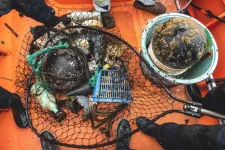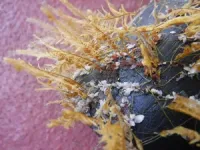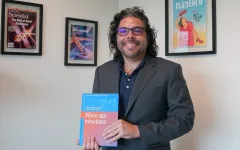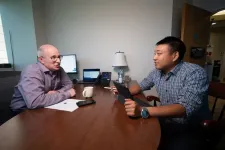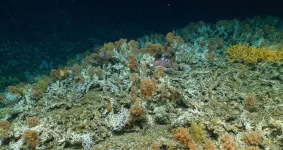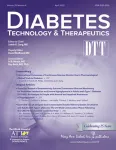(Press-News.org) The high seas have been colonized by a surprising number of coastal marine invertebrate species, which can now survive and reproduce in the open ocean, contributing strongly to the floating community composition. This finding was published today in Nature Ecology and Evolution by a team of researchers led by the Smithsonian Environmental Research Center (SERC) and the University of Hawai‘i (UH) at Mānoa.
The researchers found coastal species, representing diverse taxonomic groups and life history traits, in the eastern North Pacific Subtropical Gyre on over 70 percent of the plastic debris they examined. Further, the debris carried more coastal species than open ocean species.
“This discovery suggests that past biogeographical boundaries among marine ecosystems — established for millions of years — are rapidly changing due to floating plastic pollution accumulating in the subtropical gyres,” said lead author Linsey Haram, research associate at SERC.
These researchers only recently discovered the existence of these “neopelagic communities,” or floating communities in deep ocean waters. To understand the ecological and physical processes that govern communities on floating marine debris, SERC and UH Mānoa formed a multi-disciplinary Floating Ocean Ecosystem (FloatEco) team. UH Mānoa led the assessment of physical oceanography and SERC evaluated biological and ecological dimensions of the study.
For this study, the FloatEco team analyzed 105 plastic samples collected by The Ocean Cleanup during their 2018 and 2019 expeditions in the North Pacific Subtropical Gyre, which occupies most of the northern Pacific Ocean. The field work relied on participation of both individual volunteers and non-governmental organizations.
“We were extremely surprised to find 37 different invertebrate species that normally live in coastal waters, over triple the number of species we found that live in open waters, not only surviving on the plastic but also reproducing,” said Haram. “We were also impressed by how easily coastal species colonized new floating items, including our own instruments — an observation we’re looking into further.”
“Our results suggest coastal organisms now are able to reproduce, grow, and persist in the open ocean — creating a novel community that did not previously exist, being sustained by the vast and expanding sea of plastic debris,” said co-author Gregory Ruiz, senior scientist at SERC. “This is a paradigm shift in what we consider to be barriers to the distribution and dispersal of coastal invertebrates.”
While scientists already knew organisms, including some coastal species, colonized marine plastic debris, scientists were unaware until now that established coastal communities could persist in the open ocean. These findings identify a new human-caused impact on the ocean, documenting the scale and potential consequences that were not previously understood.
“The Hawaiian Islands are neighbored in the northeast by the North Pacific garbage patch,” said Nikolai Maximenko, co-author and senior researcher at the UH Mānoa School of Ocean and Earth Science and Technology. “Debris that breaks off from this patch constitutes the majority of debris arriving on Hawaiian beaches and reefs. In the past, the fragile marine ecosystems of the islands were protected by the very long distances from coastal communities of Asia and North America. The presence of coastal species persisting in the North Pacific Subtropical Gyre near Hawai‘i is a game changer that indicates that the islands are at an increased risk of colonization by invasive species.”
“Our study underscores the large knowledge gap and still limited understanding of rapidly changing open ocean ecosystems,” said Ruiz. “This highlights the need for dramatic enhancement of the high-seas observing systems, including biological, physical and marine debris measurements.”
END
Coastal species persist on high seas on floating plastic debris
2023-04-17
ELSE PRESS RELEASES FROM THIS DATE:
UCF researchers create digital map of sympathetic nervous system
2023-04-17
UCF Researchers Create Digital Map of Sympathetic Nervous System
A team of UCF College of Medicine researchers has created a digital topographical map of the cardiac sympathetic neural network, the region that controls the body’s heart rate and its “fight-or-flight” response. They hope this map will eventually serve as a guide to treat cardiovascular conditions using bioelectronic devices.
The study, led by Dr. Zixi Jack Cheng, a neuro-cardiovascular scientist, was published in the Scientific Reports journal ...
UCF scientist publishes book on emergence of new pathogens
2023-04-17
Climate change may be linked to an increase in the emergence of new pandemics, according to a new book published by an internationally recognized College of Medicine microbiologist.
Dr. Salvador Almagro-Moreno has teamed with fellow molecular biologist Dr. Stefan Pukatzki of City University New York – CUNY, to author the book titled Vibro spp. Infections, recently published by Springer Nature and includes the latest scientific research articles in this field from experts worldwide.
The book examines the factors associated with ...
Prime editing shows proof of concept for treating sickle cell disease
2023-04-17
(MEMPHIS, Tenn. – April 17, 2023) Sickle cell disease (SCD) is a serious blood disorder affecting millions of people, primarily those of African descent. A mutation in the gene that encodes a subunit of the oxygen-carrying molecule, hemoglobin, causes the disease. Scientists at St. Jude Children’s Research Hospital and the Broad Institute of MIT and Harvard showed a precise genome editing approach, prime editing, can change mutated hemoglobin genes back to their normal form in SCD patient cells, which restores ...
JNM publishes appropriate use criteria for lymphoscintigraphy in sentinel node mapping and lymphedema/lipedema
2023-04-17
Reston, VA—The Society of Nuclear Medicine and Molecular Imaging (SNMMI) and 10 other professional societies have issued new appropriate use criteria (AUC) for lymphoscintigraphy in sentinel node mapping and lymphedema/lipedema. The criteria, summarized in the April issue of The Journal of Nuclear Medicine (JNM), include a list of relevant clinical scenarios, a systematic review of evidence in the literature, and a systematic analysis of available evidence, followed by grading each of the clinical scenarios.
Sentinel lymph nodes ...
Father of the photonic bandgap to speak at Utah State University
2023-04-17
Renowned physicist, engineer and entrepreneur Eli Yablonovitch will visit Utah State University on April 25 for two lectures about his work in the electrical and computer engineering field.
Yablonovitch, who is currently a professor emeritus at the University of California Berkeley, will present lectures on controlling carbon intake as a solution to climate change and on physics and optimization in the engineering world. The lectures will take place on April 25, at 1 pm and 3 pm respectively. An RSVP form can be found on this webpage. All are encouraged to attend.
“Having Dr. Yablonovitch travel to speak to us is a great honor and a great opportunity for us ...
Scientists discover pristine deep-sea coral reefs in the Galápagos Marine Reserve
2023-04-17
17 April 2023 - Galápagos, Ecuador – Scientists have discovered extensive, ancient deep-sea coral reefs within the Galápagos Marine Reserve (GMR) – the first of their kind ever to be documented inside the marine protected area (MPA) since it was established in 1998. The first reef observed was found at 400-600m (1,310-1,970 feet) depth at the summit of a previously unmapped seamount in the central part of the archipelago and supports a breathtaking mix of deep marine life.
Cresting the ridge of a submerged volcano, and stretching over several kilometers, the impressive reef structure was first recorded by Dr. Michelle ...
New discovery stops bacterial virus contamination
2023-04-17
A new discovery by researchers at the University of Warwick could help stop bacteria being contaminated with viruses, reducing disruption and decreasing costs in industry and research.
Bacteria are routinely used in biological and biomedical research. They are crucial in food production and emerging industrial biotechnologies, where bacterial ‘factories’ can be used to produce new materials, medicines and chemicals. Industrial biotechnology uses microorganisms as alternatives to traditional ...
A meta-analysis of hybrid-closed loop control-IQ technology
2023-04-17
A new study evaluated the effect of hybrid-closed loop Control-IQ technology in the pooled data from three randomized controlled trials, comparing Control-IQ to a control group using continuous glucose monitoring in people with type 1 diabetes. The study, which examined subgroup based on baseline characteristics such as race/ethnicity, socio-economic status, pre-study insulin delivery modality, and baseline glycemic control, is published in the peer-reviewed journal Diabetes Technology & Therapeutics (DTT). Click here to read the article now.
Roy W. Beck, MD, PhD, from the JAEB ...
Leaps in artificial blood research aim to improve product safety, efficacy
2023-04-17
COLUMBUS, Ohio – Researchers have made huge strides in ensuring that red blood cell substitutes – or artificial blood – are able to work safely and effectively when transfused into the bloodstream.
The key is to make the artificial blood molecules big enough so they don’t leak from blood vessels into tissue and cause dangerous cardiovascular side effects, notes a new study led by researchers from The Ohio State University.
Although blood loss is typically treated by transfusing units of donated blood, in cases where transfusions aren’t readily ...
Ye receives funding for collaborative research: Ri: Small: Motion Field Understanding for Enhanced Long-Range Imaging
2023-04-17
Jinwei Ye, Assistant Professor, Computer Science, received funding from the National Science Foundation for the project: "Collaborative Research: RI: Small: Motion Field Understanding for Enhanced Long-Range Imaging."
Ye is collaborating with Nianyi Li, Assistant Professor of Computer Science at Clemson University, and Suren Jayasuriya, Assistant Professor, Arts Media and Engineering, and Assistant Professor, School of Electrical, Energy and Computer Engineering, at Arizona State University.
As ...
